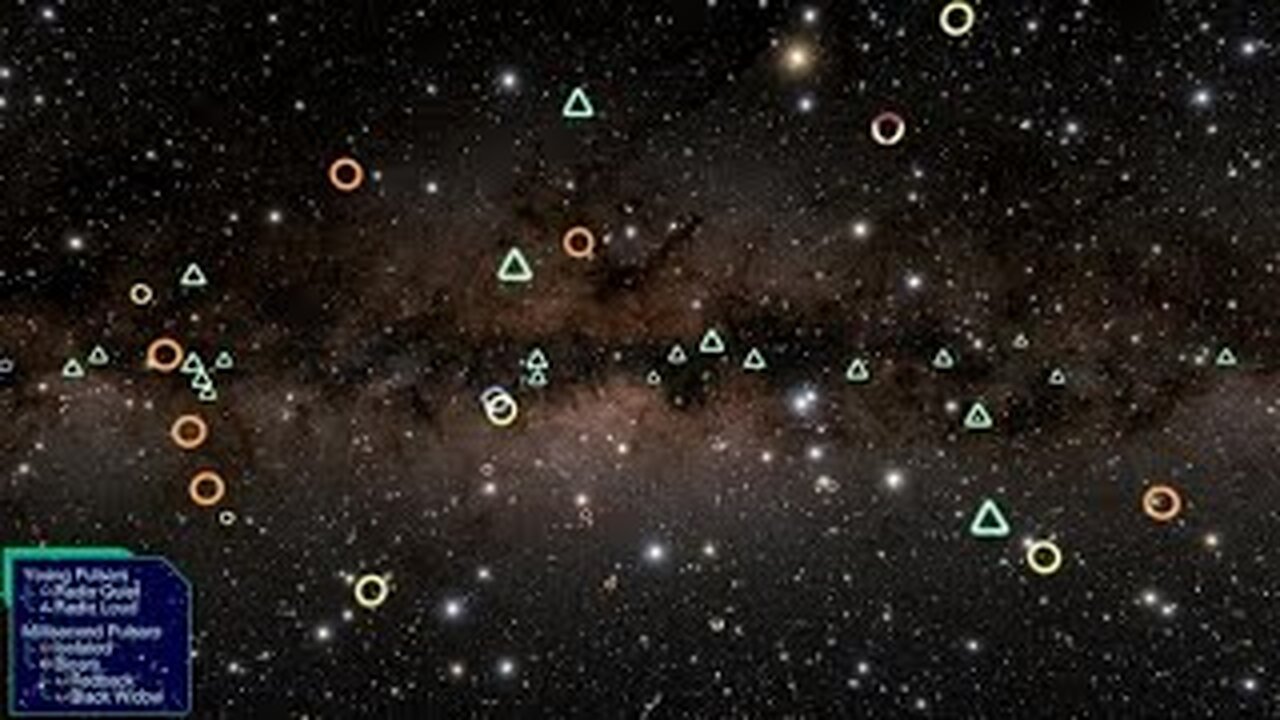Premium Only Content

NASA’s Fermi Mission Finds 300 Gamma-Ray Pulsars
This visualization shows 294 gamma-ray pulsars, first plotted on an image of the entire starry sky as seen from Earth and then transitioning to a view from above our galaxy. The symbols show different types of pulsars. Young pulsars blink in real time except for the Crab, which pulses slower because its rate is only slightly lower than the video frame rate. Millisecond pulsars remain steady, pulsing too quickly to see. The Crab, Vela, and Geminga were among the 11 gamma-ray pulsars known before Fermi launched. Other notable objects are also highlighted. Distances are shown in light-years (abbreviated ly).
A new catalog produced by a French-led international team of astronomers shows that NASA’s Fermi Gamma-ray Space Telescope has discovered 294 gamma-ray-emitting pulsars, while another 34 suspects await confirmation. This is 27 times the number known before the mission launched in 2008.
Pulsars touch on a wide range of astrophysics research, from cosmic rays and stellar evolution to the search for gravitational waves and dark matter. They are a type of neutron star, the city-sized leftover of a massive sun that has exploded as a supernova. Neutron stars, containing more mass than our Sun in a ball less than 17 miles wide, represent the densest matter astronomers can study directly. They possess strong magnetic fields, produce streams of energetic particles, and spin quickly 716 times a second for the fastest known. Pulsars, in addition, emit narrow beams of energy that swing lighthouse-like through space as the objects rotate. When one of these beams sweeps past Earth, astronomers detect a pulse of emission.
The new catalog represents the work of 170 scientists across the globe. A dozen radio telescopes carry out regular monitoring of thousands of pulsars, and radio astronomers search for new pulsars within gamma-ray sources discovered by Fermi. Other researchers have teased out gamma-ray pulsars that have no radio counterparts through millions of hours of computer calculation, a process called a blind search.
Fermi's neutron star discoveries even extend beyond our galaxy. The mission discovered the first gamma-ray pulsar in another galaxy, the neighboring Large Magellanic Cloud, in 2015. And in 2021, astronomers announced the discovery of a giant gamma-ray flare from a magnetar — a different type of neutron star — located in the Sculptor galaxy, about 11.4 million light-years away.
Music credit : "Fascination" from Universal Production Music
Credit: NASA's Goddard Space Flight Center
Producer: Scott Wiessinger (KBR Wyle Services, LLC)
Visualizer: Mark SubbaRao (NASA/GSFC) [Lead]
Visualizer: A. J. Christensen (AVL NCSA/University of Illinois)
Science writer: Francis Reddy (University of Maryland College Park)
Editor: Scott Wiessinger (KBR Wyle Services, LLC)
Scientist: David A. Smith (Laboratoire d'Astrophysique de Bordeaux) [Lead]
Scientist: Elizabeth Hays (NASA/GSFC)
-
 2:48
2:48
Steven Crowder
6 hours agoCROWDER CLASSICS: What’s This? | Nightmare Before Kwanzaa (Nightmare Before Christmas Parody)
151K10 -
 LIVE
LIVE
LFA TV
8 hours agoLFA TV CHRISTMAS EVE REPLAY
738 watching -
![ROSEANNE BARR - Her Journey, TRUMP, and the MAGA GOLDEN AGE! [INTERVIEW]](https://1a-1791.com/video/s8/1/M/m/B/2/MmB2v.0kob.1-small-ROSEANNE-BARR-Her-Journey-T.jpg) 51:35
51:35
Dr Steve Turley
1 day ago $8.34 earnedROSEANNE BARR - Her Journey, TRUMP, and the MAGA GOLDEN AGE! [INTERVIEW]
18.2K20 -
 LIVE
LIVE
The Tom Renz Show
1 hour agoMerry Christmas - The Tom Renz Show Christmas
363 watching -
 2:59:10
2:59:10
Wendy Bell Radio
12 hours agoThe Bridge Too Far
107K107 -
 1:03:45
1:03:45
Donald Trump Jr.
1 day agoHappy Festivus: Airing Our Grievances and Stopping The Swamp w/Sean Davis | TRIGGERED Ep.201
385K493 -
 1:30:30
1:30:30
Game On!
15 hours ago $6.61 earnedTop 5 things you need to know for Sports Christmas!
44.2K3 -
 1:58:10
1:58:10
Robert Gouveia
1 day agoMatt Gaetz REJECTS Report, Sues Committee; Luigi Fan Club Arrives; Biden Commutes; Festivus Waste
270K206 -
 1:31:40
1:31:40
Adam Does Movies
1 day ago $14.82 earnedThe Best & Worst Christmas Movies! - LIVE!
99.2K8 -
 58:10
58:10
Kimberly Guilfoyle
1 day agoAmerica is Back & The Future is Bright: A Year in Review | Ep. 183
189K70